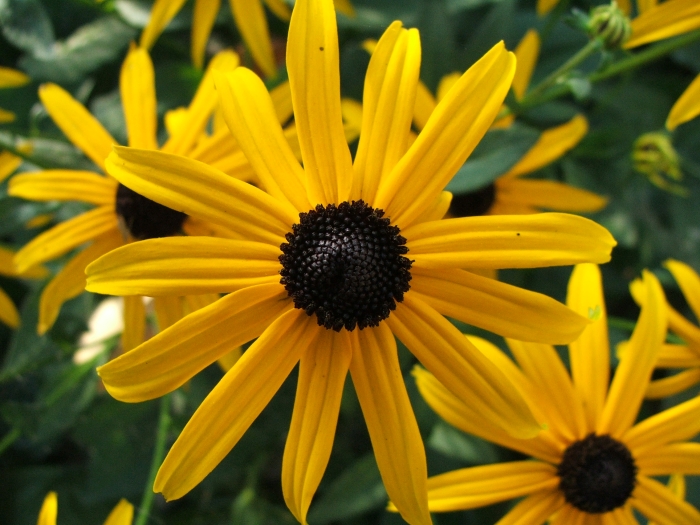Orange Coneflower
(Rudbeckia fulgida)
Orange Coneflower (Rudbeckia fulgida)
/
/

Jerzy Opioła (Poland)
CC BY-SA 3.0
Image By:
Jerzy Opioła (Poland)
Recorded By:
Copyright:
CC BY-SA 3.0
Copyright Notice:
Photo by: Jerzy Opioła (Poland) | License Type: CC BY-SA 3.0 | License URL: http://creativecommons.org/licenses/by-sa/3.0/ | Uploader: Selso | Publisher: Wikipedia Commons | Title: Rudbeckia_fulgida.JPG | Notes: Rudbeckia fulgida (pl. Rudbekia błyskotliwa), Family:Asteraceae (pl. Astrowate) | ObjectName: Rudbeckia fulgida | UsageTerms: Creative Commons Attribution-Share Alike 3.0 |










































































Estimated Native Range
Summary
Rudbeckia fulgida, commonly known as Orange Coneflower, is a herbaceous perennial that is native to open woodlands, meadows, and prairies of the Eastern and Central USA. It typically grows to a height and width of 2-3 feet (0.6-0.9 meters). The plant forms clumps of upright stems with lance-shaped leaves and daisy-like flowers featuring a prominent, cone-shaped, brownish-black center disk surrounded by bright yellow to orange petals, blooming mainly from late summer to mid-fall.
The Orange Coneflower is valued for its long blooming period and its ability to attract butterflies and other pollinators. It is commonly used in borders, wildflower gardens, and as a naturalizing plant. This species thrives in full sun to light shade and prefers consistently moist, well-drained soils, although it is tolerant of drought once established. It is relatively low maintenance and can be divided every few years to maintain vigor. Potential problems include powdery mildew and leaf spot, especially in humid conditions or overcrowded plantings.CC BY-SA 4.0
The Orange Coneflower is valued for its long blooming period and its ability to attract butterflies and other pollinators. It is commonly used in borders, wildflower gardens, and as a naturalizing plant. This species thrives in full sun to light shade and prefers consistently moist, well-drained soils, although it is tolerant of drought once established. It is relatively low maintenance and can be divided every few years to maintain vigor. Potential problems include powdery mildew and leaf spot, especially in humid conditions or overcrowded plantings.CC BY-SA 4.0
Plant Description
- Plant Type: Herb
- Height: 2-3 feet
- Width: 2-2.5 feet
- Growth Rate: Moderate
- Flower Color: Yellow, Brown
- Flowering Season: Summer, Fall
- Leaf Retention: Deciduous
Growth Requirements
- Sun: Full Sun
- Water: Medium
- Drainage: Medium, Fast
Common Uses
Bee Garden, Bird Garden, Border Plant, Butterfly Garden, Deer Resistant, Drought Tolerant, Groundcover, Hummingbird Garden, Low Maintenance, Potted Plant, Rabbit Resistant, Salt Tolerant, Showy Flowers, Street Planting
Natural Habitat
Open woodlands, meadows, and prairies of the Eastern and Central USA
Other Names
Common Names: Perennial Coneflower
Scientific Names: , Rudbeckia fulgida, Rudbeckia foliosa, Rudbeckia acuminata, Rudbeckia discolor, Rudbeckia newmani, Rudbeckia scabra, Centrocarpha acutifolia, Centrocarpha chrysomela, Centrocarpha discolor
GBIF Accepted Name: Rudbeckia fulgida Aiton